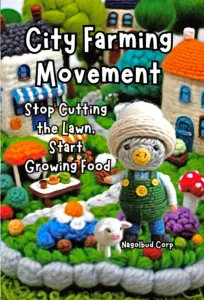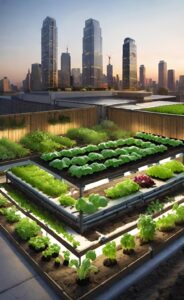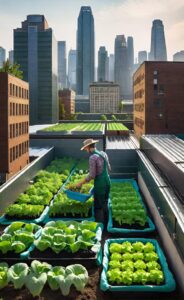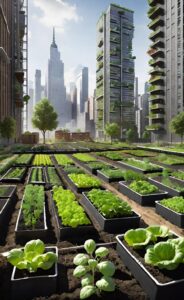Welcome to the revolution in urban living that turns lawns into luscious landscapes of fresh produce. The City Farming Movement is making waves in urban communities across the country, transforming unused lawn spaces into productive, eco-friendly farms. It’s not just about gardening, but about sustainability, community building, and a healthier lifestyle. Ready to swap your lawnmower for a hoe?
Understanding Nagolbud’s City Farming Movement
Nagolbud’s City Farming Movement is a paradigm shift in the utilization and perception of our urban environments. The concept revolves around a simple but revolutionary idea, swapping your lawn grass with crops. This is about freeing yourself from the time-consuming tasks of mowing, fertilizing, and watering a decorative lawn, and instead cultivating an array of vegetables, herbs, and fruits right in your urban setting, transforming it into a micro-farm. But this movement transcends the mere act of farming, it serves as a foundation for resilient and sustainable communities, built on local production and communal resource sharing.
Benefits of Turning Your Lawn Into a Farm
When you transform your lawn into a farm, you tap into a wellspring of advantages. Picture stepping out of your door and plucking fresh, organic produce from your backyard to prepare meals. This convenience factor is matched by the significant reduction in grocery bills as you essentially grow your groceries. Moreover, the produce from your lawn farm is devoid of pesticides, offering a healthier alternative to store-bought goods.
Cultivating your own crops is also an effective stress buster. The act of nurturing a seed into a fully-grown plant can offer immense satisfaction and serve as a therapeutic activity. It provides an excellent workout too, helping you stay fit and active. So, by switching from a lawn to a farm, you invite a host of benefits that enhance your health, well-being, and contribute to a more sustainable community.
City Farming and Local Community Building
City farming isn’t just about transforming your lawn into a thriving food source, it’s a powerful tool for knitting tighter community bonds. This agricultural shift can transform your backyard into a community gathering spot, providing a common space where neighbors can exchange farming tips, share tools, and even divide harvests. It’s an engaging, hands-on way for children to learn about the origins of their food, from the sowing of seeds to the harvesting of crops. This interaction fosters a sense of responsibility and appreciation for nature among the younger generation.
For adults, too, the shared purpose of nurturing and caring for plants can instill a greater sense of community and interconnectedness. This shared endeavor can ultimately lead to more robust, supportive neighborhoods. The city farming movement isn’t just a path to sustainable food production, it’s a seed for stronger, more vibrant communities.

> Check Current Book Prices <
How City Farming Contributes to Sustainable Living
City farming plays a significant role in fostering sustainable lifestyles, chiefly through its emphasis on localized food production, reduced food waste, and incorporation of a closed-loop system. By cultivating your own produce, you lessen reliance on industrial farming. Furthermore, homegrown crops typically generate less waste than store-bought produce, as they bypass the processes of packaging, shipping, and displaying in stores that often result in spoilage and excess waste.
Also integral to city farming is the practice of composting, which transforms organic waste into nutrient-rich soil. This process not only reduces the amount of waste heading to landfills, but also enhances the fertility of your garden, leading to more abundant and healthier crops.
Additionally, city farms commonly harness rainwater for irrigation, a practice that reduces water consumption and makes the most of a natural resource that would otherwise go to waste. The rainwater is stored and reused, providing a natural and sustainable water source for your crops.
Through these methods, city farming not only feeds us, but also nurtures our environment. This urban agricultural practice strengthens the resilience of our cities, making them less dependent on outside resources, more eco-friendly, and ready for a future where sustainability is paramount.



Maximizing Your Yard Space for a City Farm
Turning your lawn into a city farm doesn’t require an expansive space. In fact, even the smallest of balconies or patios can yield a bountiful harvest with the help of container gardening. To optimize the available area, consider leveraging vertical spaces. You can grow vining plants or install shelves to accommodate pots and containers. Choosing crops that thrive in your specific climate and soil conditions can also significantly improve your farm’s productivity.
Carefully planning and laying out your garden can ensure you maximize the full potential of your yard, transforming even the smallest patch of grass into a thriving mini farm. Don’t shy away from creativity, consider raised beds, trellises or hanging baskets to make the most of every inch. Remember, city farming is not about how much space you have, but how you utilize it.
Initiating the Transformation from Lawn to Farm
Venturing into city farming may seem challenging initially, but it’s a journey worth embarking on. The first step is educating yourself about the type of plants that thrive in your local climate and learning the best ways to nurture them. Consider starting on a small scale with container gardening, opting for herbs or vegetables that are easy to grow in pots, such as tomatoes, peppers, or basil. As you gain confidence and experience, you can gradually add a wider variety of crops to your urban farm.
Involving your neighbors in your city farming endeavors not only shares the responsibility but also fosters a sense of community. Pool resources, exchange gardening tips, and make the transformation a collective effort. Your lawn can be a communal space that brings together your neighborhood, while serving as an educational platform for younger generations about sustainable living.
City farming is not just about cultivating crops in your backyard, it’s an invitation to adopt a more sustainable lifestyle, build stronger communities, and establish a deeper connection with the earth. So, it’s time to put away the lawnmower, roll up your sleeves, and dive into the enriching world of city farming.






